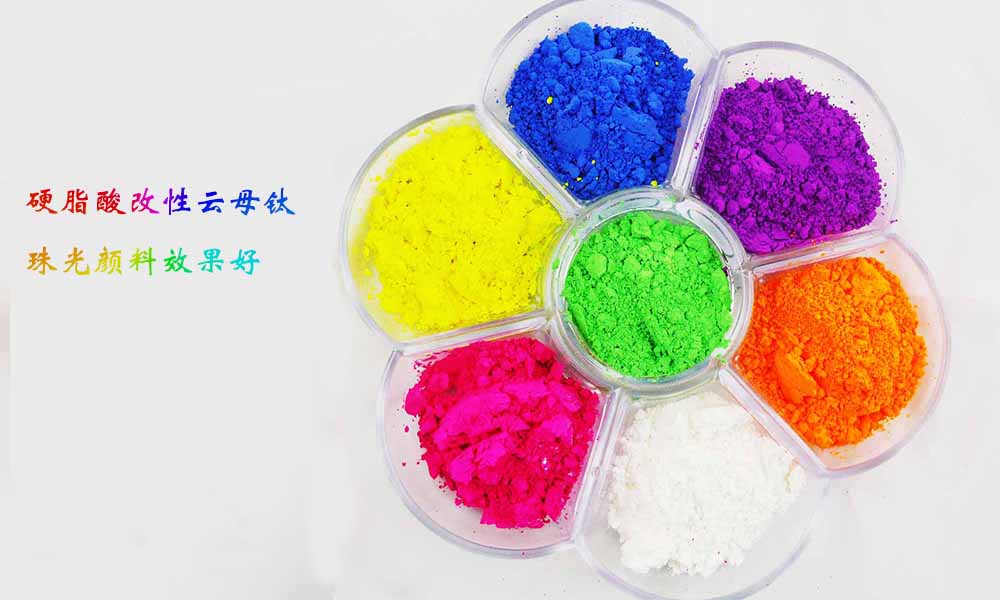
Mica titanium pearlescent pigment is a new type of inorganic pearlescent pigment that mainly containsSiO2 and TiO2. It has good chemical stability, weather resistance, optical properties, non-toxicity and high decorative properties. It is mainly used in the coating industry, plastics industry, cosmetics industry and building materials industry.
1. The necessity of modification of titanium mica pearlescent pigment
Since mica-titanium pearlescent pigments are Inorganic pigments easily carry hydroxyl groups on their surfaces and exhibit good hydrophilic properties. When used as pigments and added to organic solvents (such as paints, rubbers, plastics or cosmetics), they interact with the organic phase. Different interface properties and poor compatibility lead to shortcomings such as agglomeration and uneven dispersion of mica-titanium pearlescent pigments. When added to powder coatings, problems such as low powder loading rate and serious electrostatic spray separation under different voltages are likely to occur.
By using mica titanium pearlescent pigments The powder is surface modified to improve its dispersion and compatibility in organic solvents and other properties, and to improve its powder loading rate and stability in powder coatings.
2. Stearic acid modified mica titanium pearlescent pigment
(1) Stearic acid coated mica titanium pearlescent pigment process
Modified mica with stearic acid The optimal process for titanium pearlescent pigments is: the reaction time is 2h, the reaction temperature is 70°C, and the stearic acid dosage is 2.0%.
(2) Modification principle
During the powder modification process, the carboxyl group in stearic acid -COOH will form a chemical bond with the hydroxyl group (-OH) on the surface of the pearlescent pigment powder, and the long-chain groups will be entangled with each other, so that the surface of the powder is connected with lipophilic groups, which has a good hydrophobic and lipophilic effect.
(3) Modification effect
Modified pearlescent pigment powder, through lipophilicity, sedimentation volume and Tests in the water/oil phase show that its compatibility with the organic phase is significantly better than that of unmodified pearlescent pigments;
Mica titanium pearlescent pigment, although it has good lipophilic and hydrophobic effects, its crystal structure has not been destroyed, so the mica is still retained Titanium pearlescent pigment has the original physical properties of golden luster;
The surface of the modified titanium mica pearlescent pigment is connected with lipophilic functional groups. Unmodified titanium mica pearlescent pigments are easy to aggregate. After modification, some nanoparticles in the clay slurry are adsorbed on the surface. This not only makes the titanium mica pearlescent pigments have a good hydrophobic effect, but also improves adsorption during spraying. The ability to negatively charge, enhance the beadiness of the paint film� effect.
3. The use of modified pearlescent pigments in powder coatings Application
Stearic acid-modified titanium mica pearlescent pigments can be combined with powder coatings in a suitable manner to prepare pearlescent powder coatings.
Pair of pearlescent The performance and spraying effect of the powder coating were tested, and the results showed that:
(1) The powder coating rate of hard acid modified mica titanium pearlescent pigments is higher than that of untreated pearlescent pigments:
(2) The modified titanium mica pearlescent pigment can reduce the shrinkage phenomenon of the paint film, and the color difference deviation is small:
(3) When spraying after mixing by dry mixing, the amount of stearic acid-modified pearlescent pigment can be reduced by 1/3 compared with untreated one; and After bonding and spraying, the amount of modified pearlescent pigment is reduced by 20%.
In contrast, after The effect of mixing the stearic acid-modified pearlescent pigments and powder coatings uniformly using the dry mixing method and then spraying is better than the uniform mixing using the bonding method, which has great guiding significance for the production of enterprises.
4. Introduction to stearic acid:
Stearic acid, alias: Octadecanoic acid|Octadecanoic acid|Fat wax. Stearic acid is a fatty acid widely found in nature. Almost all oils contain stearic acid in varying amounts. The content is higher in animal fats. For example, the content in butter can reach 24%. The content in vegetable oils is smaller, such as camellia oil. It is 0.8%, palm oil is 6%, but the content in cocoa butter is as high as 34%. According to the supply of stearic acid, there are two main production methods of industrial stearic acid: fractionation method and pressing method. A decomposing agent is added to the hardened oil, and then it is hydrolyzed to obtain crude fatty acids, which are then washed, distilled, and decolorized to obtain the finished product, while glycerol is produced as a by-product.
Physical properties:
1. Properties: white waxy transparent solid or slightly yellow waxy solid. Can be dispersed into powder with slight butter smell.
2. Relative density (g/mL, 20/4℃): 0.9408
3. Relative vapor density (g/mL, air=1): Undetermined
4. Melting point (oC): 67~69
5 Boiling point (oC, normal pressure): 183~184 (133.3pa)
6. Boiling point (oC, 5.2kPa): 360
7. Refractive index (n20D): 1.455
8. Flash point (oC): >110
9. Solubility: Insoluble in water, slightly soluble in cold ethanol, and easier to dissolve when heated. Slightly soluble in acetone and benzene, easily soluble in ether, chloroform, hot ethanol, carbon tetrachloride and carbon disulfide.
pan style=”;font-family:宋体;color:rgb(12,12,12);font-size:14px”>
8. Flash point (oC):>110
9. Solubility: Insoluble in water, slightly soluble in cold ethanol, and easier to dissolve when heated. Slightly soluble in acetone and benzene, easily soluble in ether, chloroform, hot ethanol, carbon tetrachloride and carbon disulfide.
</span



 微信扫一扫打赏
微信扫一扫打赏
